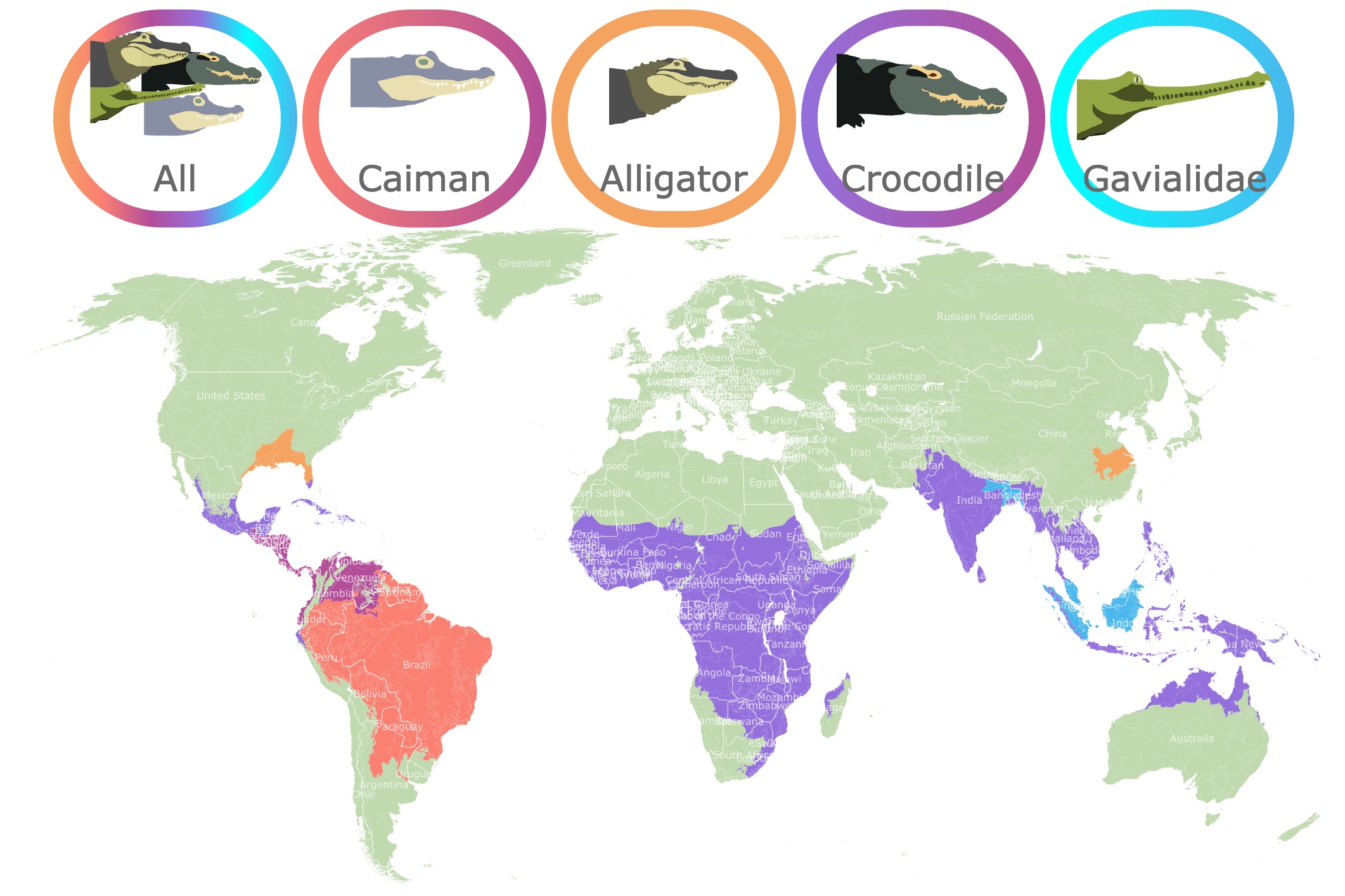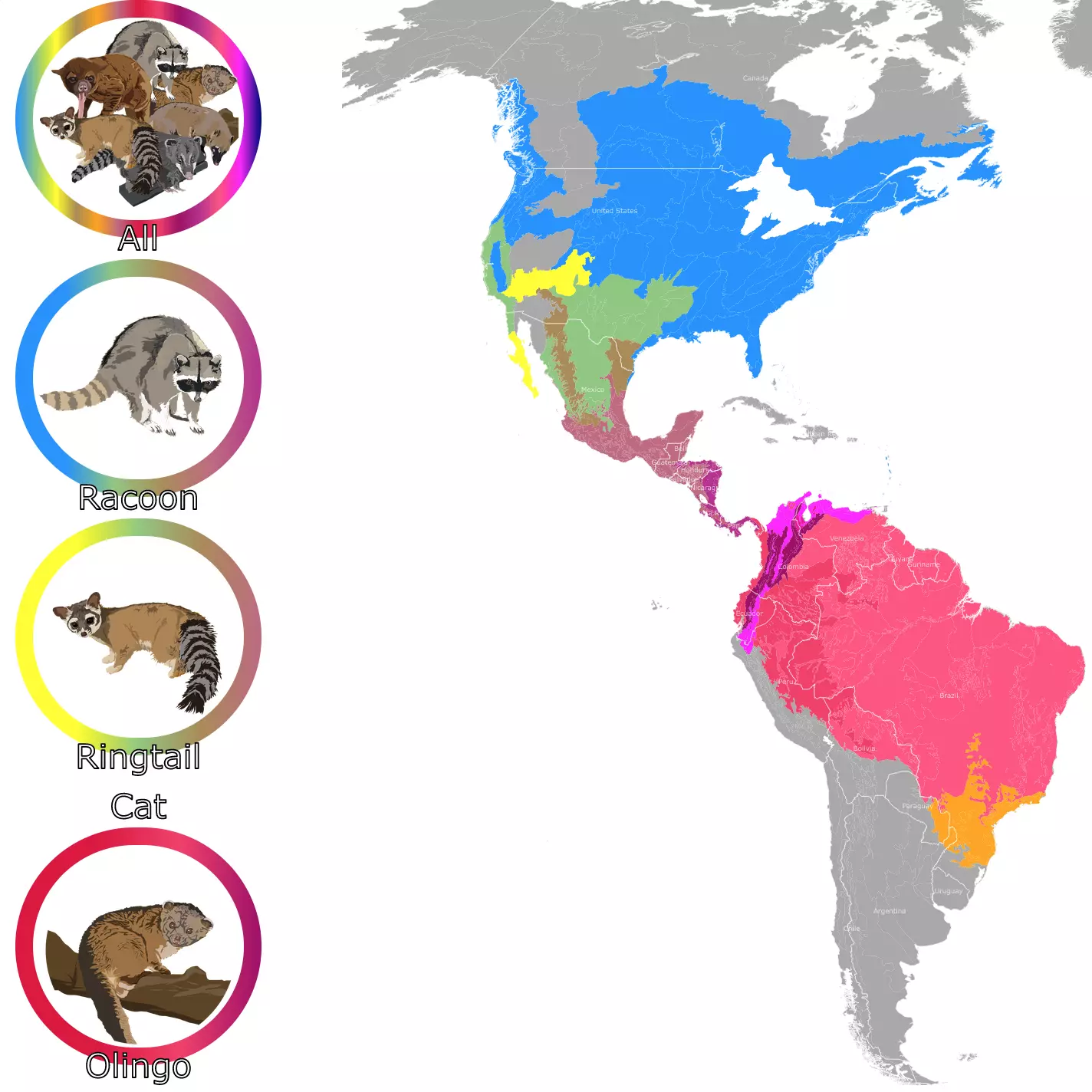Crocodile Habitat Map
This map shows the overlapping habitats of Crocodiles, Alligators, Caimans, and Gavilidae. The ring around the images has the colors of the different ecoregions, each group occupies. Due to range overlapping, a single group might have more than one color. Each image is a button that you can select to pick the distribution of a particular type. Zoom in the map to take a closer look! Hover to get the name of the ecoregion. For more information scroll down.
Crocodile Facts
This map shows the habitat of the extant members of the order Crocodilia. The distribution on this map is approximate as some species have been hunted and their exact population is not known.
Crocodilians are any of several large, carnivorous, thick-skinned, long-bodied, aquatic reptiles that live in the tropics and subtropics. They are considered the largest freshwater inhabitants.
They are remarkable animals because they have survived when other groups of large reptiles have perished. Crocodiles are a living link with prehistoric dinosaurs and are the nearest living relatives of birds!
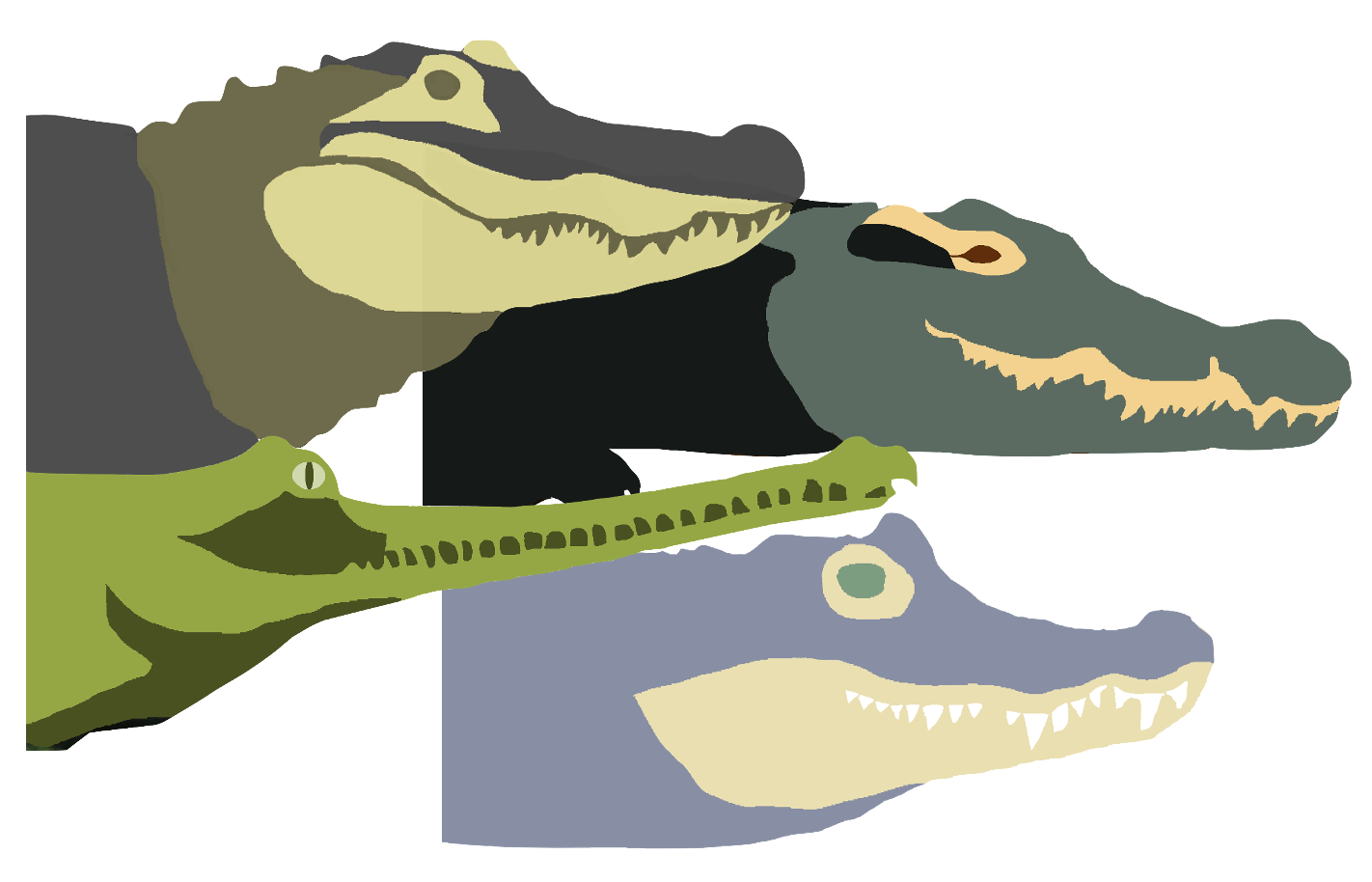
Crocodilians are "key stone species" or a species the ecosystem is largely dependent on. This is because crocodiles have selective predation on fish, they recycle nutrients, and provide refugee to small organisms during dry seasons.
Crocodiles are sensitive to climatic fluctuations. As shown in this map, they are found throughout the world in tropical and subtropical forests because they are sensitive to temperature changes and cold temperatures.
They are restricted to aquatic or estuarine environments like rivers, forest streams, swamps, marshes, and bayous. Occasionally, they adapt to salty waters like those of mangroves and estuaries.
Crocodiles are considered to be water dependent because they can only mate in water.
They are carnivorous and nocturnal. They are also opportunistic predators and their diet depends on their age, species, and prey diversity. Diversity of Crocodiles
Crocodile skin is covered with scales or scutes and have no sweat glands. On the head, their skin is fused to the skull. Crocodiles have Integument Sense Organs. These are specialized sensory nerve structures on their skin.
"Crocodiles are the only reptiles with an external ear" Crocodiles.
The nostrils, eyes, and ears of crocodilians are high on the head. This allows them to float in the water with very little of their bodies exposed. This camouflage keeps young crocs safe from predators and helps them ambush prey.
Crocodiles will drag animals to the water where they will roll to disorient the prey. Then will dismember it and eat it.
Crocodilians lay eggs on plant material and mud tuned into nests. Adults respond to hatchlings distress cries. Some species of adults will attend hatchlings for several weeks.
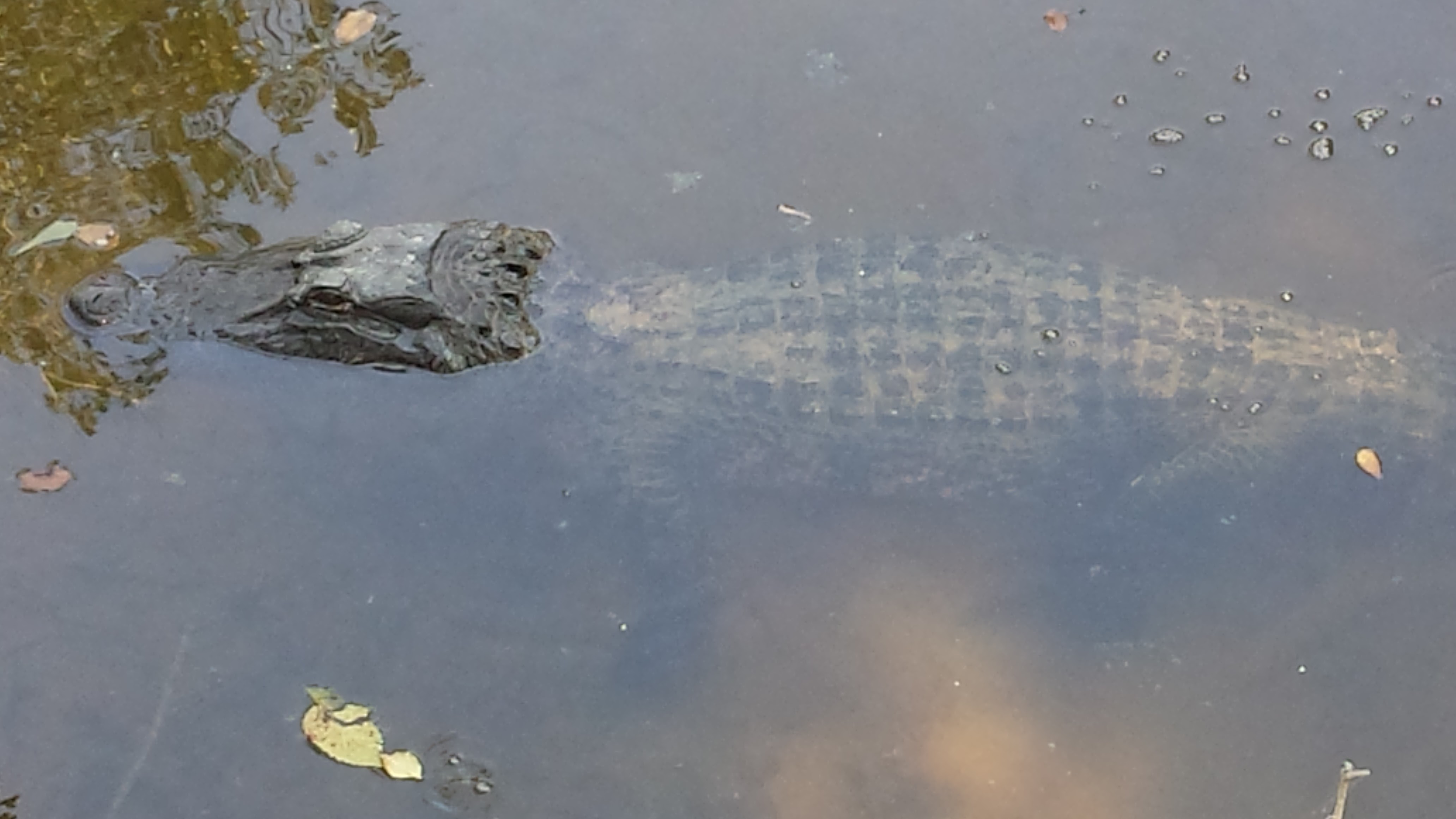
Crocodile Groups
There are 24 species of living cocodrilians divided into 4 major groups: Alligators, Caimans, Crocodiles, and Gavilidae.
The most diverse group is Crocodylus, which has 13 species.
The relationships of among the members of this order are shown on the table below.
| Crocodilia | Alligatoridae | Caiman | Caiman | |
| Melanosuchus: Black Caiman | ||||
| Paleochus | ||||
| Alligator | Alligator | |||
| Crocodylidae | Crocodylus | |||
| Mecistops: Slender Snouted Crocodile | ||||
| Osteolaemus: Dwarf Crocodile | ||||
| Gavilidae | Gavialis: Gharial | |||
| Tomistoma: False gharial | ||||
Before the descriptions of each family of Crocodilia it is important to highlight the differences between the major groups.
Crocodile vs Alligator
When looking into this reptiles you may ask what is the difference between Crocodiles and Alligators? Here is a concise answer:
| Crocoldylidae family | Alligatordae family |
| Crocodiles can live in freshwater and saltwater environments. | Alligators prefer freshwater environments. |
| Crocodiles usually have longer snouts, almost like a V shape | Alligators usually have shorter rounded snouts, almost like a U shape. |
| Crocodiles are regarded as more aggressive than alligators, they are more dangerous. | Alligators are seen as less aggressive than crocodiles, they are more of opportunistic feeders. |
| Crocodiles have same size upper and lower jaws. When they close their snout you can see upper and lower teeth. | Alligators have a wider upper jaw. When they close their snout you can only see their upper teeth. |
| 15 species. | 8 species of alligators and caimans. |
| Crocodiles have Integument Sense Organs all over their body. | Alligators have Integument Sense Organs only on their head. |
| Crocodiles can be up to 20 feet. | Alligators can reach around 14 feet. |
| Crocodile skin tend to be olive, or light tan. | Alligators are usually a dark blackish grey. |
| Crocodile are a bit slower. | On land or water alligators are usually faster than crocodiles. |
| Crocodile prefer warmer climates. | Alligators are more cold resistant. |
Source: Crocodilia.com and Crocodilians.
True Crocodiles
Family Crocodylidae live in the tropical areas of the Americas, Africa, Asia, and Oceania. Unlike alligators they are very sensitive to cold temperatures.
The morphology, ecology, and behavior slightly differs between species.
Crocodiles are capable of surviving in salt water and long journeys in the ocean. They are often found in chains of islands in the Malay Archipelago as well as in islands of the West Indies.
As mentioned before they have special salt excreting glands on their tongues that help them expel the excess salt from their bodies when living in brackish or sea waters.

Crocodiles are active hunters that stalk prey both above and below water. They feed on birds, fish, reptiles, mammals, and invertebrates like crustaceans and mollusks, hence a varied diet.
Blind Crocodiles and those that are kept in dark areas tend to show a lighter color than those kept in bright light.
Some members of this group include the American Crocodile, Orinoco crocodile, Johnsone river crocodile, Philippine Crocodile, Australian saltwater crocodile, and Nile crocodile.
Largest Crocodile
As mentioned in the table above, Crocodiles are on average larger than Alligators, but How big can they be? What is the largest Crocodile?
The largest species of crocodile is the Crocodylus porosus commonly known as the Australian Saltwater Crocodile. This species is found from Northern Australia to Southeast Asia.
The Australian Saltwater Crocodile can be 19.6 feet (6 meters) long and weigh up to 2204 pounds (1000kg).
Crocodiles grow rapidly the first 2 years of life reaching 3.3 feet (1m). Growth slows after reaching 15 years or sexual maturity. Nevertheless, crocodiles keep growing until they are 60 years of age. This is when they reach their largest sizes.
Alligators
There are only two species of Alligators: The American Alligator and the Chinese Alligator.
American Alligator
The American Alligator or Alligator mississippiensis prefers murky waters in freshwater lakes and slow moving rivers, and range from North Carolina and Florida to Texas.
Alligators are opportunistic feeders. They prey on fish, snakes, birds, and small mammals.
The wider shape of their snout makes their jaws stronger than crocodiles, useful to eat turtles.
Alligators are ectothermic or cold blooded. They regulate their body temperature by laying in the sun or moving to areas with colder air, shade, or water to cool off. They may also open their mouths to cool off. MYFWC.

The American Alligators lifespan may exceed 60 years, and can reach a weight of 400 to 600 pounds with a length of 9 to 16 feet.
Because Alligators live in subtropical areas that have seasonal temperature changes, it is common for them to stop eating in winter and start eating again in Spring.
This means they survive several months without eating because their metabolism slows down when it gets cold. Source: Scovillzoo.com
If you are fascinated by the American Alligator, Amazon has a great publication about them; Alligators: The Illustrated Guide to Their Biology, Behavior, and Conservation, is a comprehensive book about the anatomy, physiology, and ecology of these reptiles. Furthermore, it examines alligator relationships with humans.
Chinese Alligator
The Chinese alligator or Alligator sinensis, is a close relative of the American Alligator.
It differs from the American Alligator by a smaller size. It measures to about 5 feet or 1.5 meters.
It has a more robust head than the American Alligator. Their eyelids have a bony plate not present in the American Alligator. They also have a plate on their belly absent in the American Alligator.
This member is special because it is the only member out of eight species of the Alligatoridae family that lives outside the Americas (one is the American Alligator and the other 6 are Caimans).
Today the Chinese alligator is found in slow moving freshwater rivers, lakes and swamps in the middle to lower Yangtze River, as shown in this map. But its current range is primarily in the Anhui and Zhejiang provinces in eastern China Smithsonian National Zoo.
Caimans
Caimans are exclusive to the Americas and prefer to live in freshwater ecosystems. Their range goes from Mexico to Argentina. This reptile used to be abundant in rivers, lagoons, and swamps, but has been reduced to isolated locations due to excesive hunting.
Some of the local names given to this group are: baba, babilla, yacare, and lagarto.
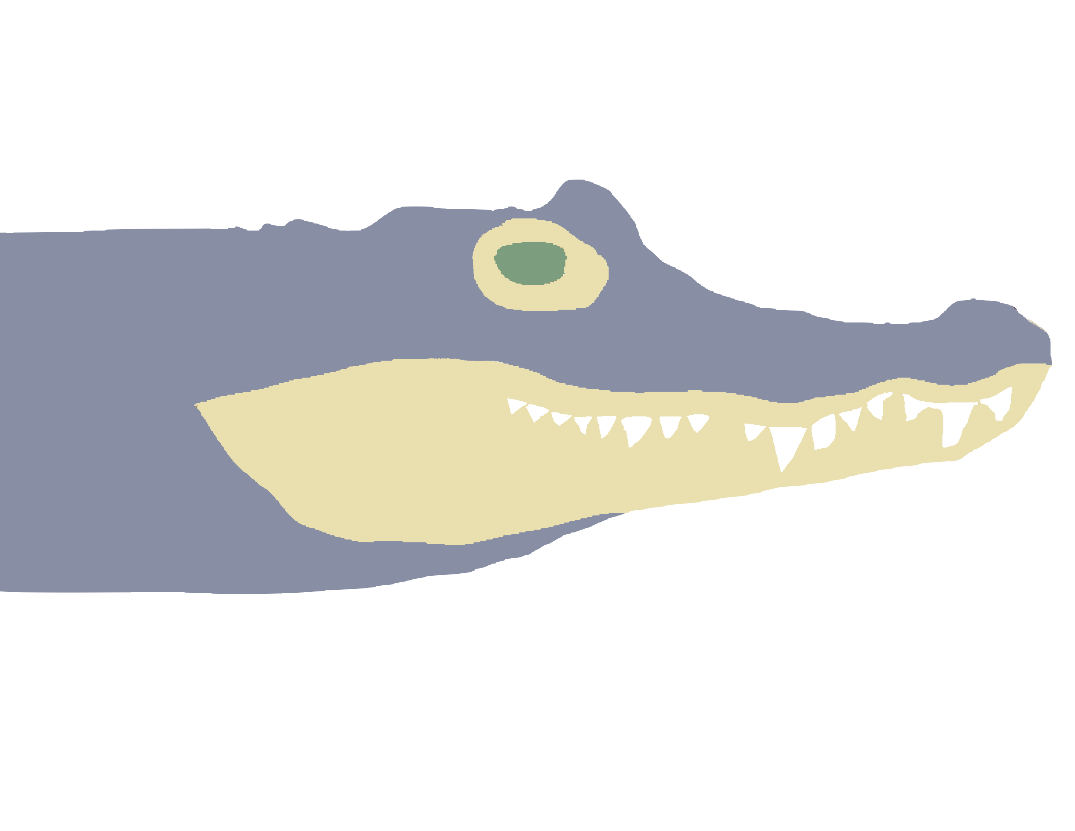
Because the temperature variability in the region is mainly given by altitude, they are commonly found in the isotherm of 24˚C or 75.2˚F. This means they are found in low elevations. In Colombia they have been found up to 2624.67feet (800m) above sea level.
Caimans are usually smaller than alligators with sizes that start in the 5 feet (1.5m) and 88 pounds. However the Black Caiman Melanosuchus niger can measure up to 16 feet (5m) and weight up to 2,400 pounds (1088 kg). Source: fao.org
Gavilidae Family
The Gavilidae include two genera each one with one species, the Gharial and the False Gharial.
Gharial
The Gharial or Gavialis gangeticus is found in northern India and Nepal. Gharials live mainly in large river systems and spend less time on land than other crocodilians.

Although they will also eat many other animals if given the chance, gharials are specialized fish-eaters. Their long, narrow snouts and thin, sharply-pointed teeth are perfect to catch their fast and slippery prey.
False Gharial
The Tomistoma schlegelii or False Gharial is a controversial member of the crocodile group. This reptile lives in Malaysia, Sumatra, and Borneo.
Like the Gharial this crocodile is characterized by a slender snout and prefer freshwater ecosystems over brackish or sea waters.
They are controversial because their morphology make them close relatives of "True Crocodiles" but genetics makes them closer to Gharial. Berkey.edu
Best Places to See Alligators

Most of these crocodiles are present in zoos and aquariums. If you come to the U.S. South, you will see them in alligator theme parks, rest stops, and even in Restaurants! Fortunately for those that can stay longer, it is easy to spot them in their natural habitat.
As a former Texas resident I can testify that it was common for us to go on hikes around Katy, TX, and see alligators in the canals and ponds of our neighborhood.
But for average tourists, there are more places to see these amazing creatures while visiting other known sites.
- Houston, Texas: Around canals or bayous, from decks at a safe distance. Even in artificial lakes in parks!
- New Orleans, Louisiana: In City Park in lagoons and waterways
- Myrtle Beach, South Carolina: In one of many parks in the area.
- The Everglades, Florida: Just on any Airboat tour and ride.
- Wakulla Springs State Park, Florida: It is easy to spot them from the boat rides provided.
No matter where you go, stay at a safe distance. You don't want to be their diner!
Threats to Crocodilians
There are some challenges to their conservation. Crocodilians are the largest predators in their habitat and can threaten humans and their livestock.
They are also exploited for their skin which supports an international trade.
The establishment of minimum harvest sizes, plus bag limits per hunters of caimans, have been implemented in Latin America. They have been used to regulate caiman hunting. Nevertheless, hunters, traders and tanners have all eluded both size and bag limits for lack of supervision. Therefore, most countries in the area have opted for a total ban as an emergency measure; Crocodiles.
The main threat facing the American alligator is the destruction and degradation of wetland habitat. This usually occurs in association with human development.
Expanding housing developments in their habitat and the invasion of stormwater lagoons along golf courses has increased the interactions with humans in the United States. As human populations increase in these areas and tourism booms along coastal habitats, there are more and more situations where alligators are being encountered University of Georgia.
Resources for Crocodile Groups Map
Regardless of the distribution shown here, most of it is probable, since most of their natural habitat is scattered or affected by human populations.
For Tomistoma distribution Crocodilian.com was used. To find the range of Alligators and Caimans Caimancocodrilus was used as reference. The extent of crocodile distribution was found on Crocodile.
The shapefiles to create the map with ecoregions of the world were obtained from WWF. The shapefiles with the countries of the world were obtained from Natural Earth.
Did you like this map? To receive updates on this and more nature maps join my email list!!!!!!!
Made by Luz K. Molina with D3.js.
